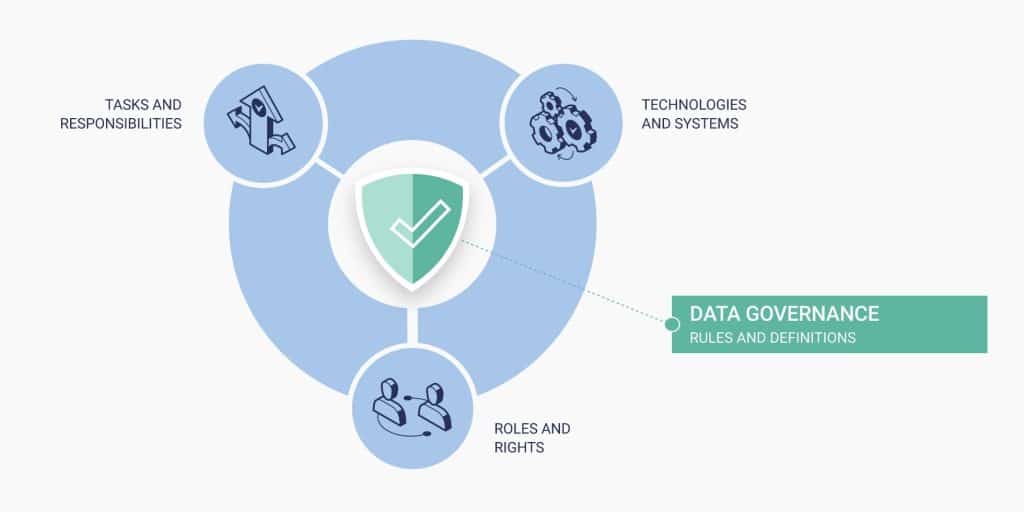Blog
What is Data Governance?
Explanation, Relevance & 5 Steps for Implementation

Data Governance is a central resource for all questions around data management.
In this guide, we’ll cover:
- The core concept of data governance,
- Why it’s essential, along with key challenges companies face in its implementation, and
- Five actionable tips for successfully implementing data governance in your organization.
What is Data Governance?
As businesses grow, data management inevitably becomes a critical focus, and today’s complex business landscape pushes companies to address it sooner than ever.
The Starting Point
Leaders typically recognize the need for data governance when data quality suffers, or there’s doubt about data accuracy or timeliness. These issues often lead to inefficiencies, delays, errors, and other operational setbacks.
Such challenges commonly stem from not establishing clear rules for handling key data—from product and customer data to employee and competitor information—early on. As a result, companies often begin addressing data governance only when data quality issues have already become noticeable.
The Approach
Data governance addresses these challenges by establishing clear processes, rules, and responsibilities for effective data management. This covers everything from data creation—using consistent naming conventions and value ranges—to processing, enrichment, and even deletion or archiving. For instance, data governance can ensure that customer names in customer service and e-commerce follow the same format, making it significantly easier to link and analyze these data points across platforms.
What does Data Governance Cover?
Data Governance encompasses:
- Centralized documentation of all rules and definitions.
- Technologies and systems that support data processes and enforce data governance guidelines, such as roles, permissions, and validation mechanisms.
- The organizational aspect, where employees are assigned specific tasks and responsibilities related to data governance. This also includes training and awareness programs, along with clear strategies to ensure everyone understands their role.
The concept of data governance can be challenging to grasp. At its core, it functions like a code that all elements within a data ecosystem must follow.
For successful data governance, it’s essential that everyone in the organization understands why these guidelines are necessary and how they add value—not only for the company as a whole but also for each individual’s work. Data governance, in this way, creates the foundation for a truly data-driven organization: one that not only embraces these rules but pursues their implementation and compliance out of intrinsic motivation.
In a data-driven company, all core workflows and decisions are grounded in reliable, meaningful data. This company’s technological, procedural, and organizational setup enables leaders to respond quickly and flexibly to changes and new insights, making a data-driven approach the goal for many businesses striving to be more agile and resilient.
A strong first step is to avoid siloing data across separate systems like ERP, CRM, and others. Instead, consolidating all data and assets into a single system as a « single source of truth » is ideal. From there, data can be easily transferred and managed. Here, PIM software—ideally paired with DAM software—is the optimal tool to achieve this.
Why is Data Governance Relevant?
Data governance lays a crucial foundation for sustainable company growth. According to Gartner, approximately 60 percent of companies will struggle to realize the potential of their AI initiatives by 2027, with inconsistent data governance as the primary obstacle.
Data Governance is essential because it directly supports the creation of real business value:
- Stronger Partner Relationships: In industries like manufacturing and retail, data exchange is critical. Manufacturers need to provide retail partners with reliable product data to get their products to market. The higher the quality and completeness of product information, the better the marketing opportunities—benefiting both manufacturers and retailers through higher sales.
- Increased Customer Satisfaction: Customers rely on accurate product information to make purchasing decisions. When information is misleading, it quickly leads to dissatisfaction, returns, and complaints.
- Effective Brand Development: Inaccurate data doesn’t just increase returns; it also poses long-term risks to brand reputation. Negative reviews in online stores or marketplaces can harm brand perception, while accurate, consistent product communication helps to build and protect brand value.
- Expanded Sales Potential: Solid data governance reduces data quality issues in distribution channels, making it easier to enter new sales channels and supply them with high-quality product data. This creates efficient, manageable processes for growth.
- Foundation for BI and Analytics: As demand for analytics and BI tools rises—the market is projected to reach $36.46 billion by 2029, according to Statista—quality data becomes even more critical. Strong data governance is thus indispensable for any data-driven insights.
What are the Challenges in Establishing Data Governance?
Despite its importance, many companies struggle to implement data governance successfully.
Establishing effective data governance necessitates a holistic view of the organization, its processes, and system architecture. Key requirements include:
- Transparent Documentation of Central Data Processes: All data processes must be clearly outlined.
- Data Quality Rules: Establishing comprehensive rules for data quality is essential.
- Identification of Responsible Parties: All individuals involved in the data processes must be documented.
This task can be daunting, particularly for larger, more complex organizations.
Moreover, many managers underestimate the measures needed to integrate data governance into employee behavior. This requires authentic change management that aligns with the principles of corporate culture. If organizations fail to recognize this as a transformation project, they will likely face ongoing challenges in implementing data governance effectively in the long term.
The 5 Most Important Tips for Implementing Data Governance
To successfully implement robust data governance, consider these five essential tips:
1. Clear Commitment from Management
Building a genuine data culture must start at the management level. Many data governance initiatives fail due to a lack of support from leadership.
2. Change Management
Employees are at the heart of data governance implementation. It’s crucial to involve them at every stage of development with a transparent transformation strategy. Additionally, provide training and education to prepare them for their new roles as data-savvy team members.
3. Holistic Overview
Designing effective data governance requires a comprehensive perspective that encompasses all business areas, software systems, tools, data sources, and data recipients. Taking a step back to see the bigger picture is essential.
4. Focus on Data Processes
Central data processes must be documented from this comprehensive starting point. Business leaders often focus too narrowly on individual use cases or software systems, overlooking the broader implications for related processes and data users.
5. Data Governance is an Ongoing Process
Setting up data governance once is not enough. Every change—be it in the system landscape, sales channels, organizational structure, or partner network—can impact data governance rules. Therefore, it’s vital to continuously validate, adapt, and refine these rules.
Establishing and embracing data governance is essential for today’s data-driven companies. There are numerous reasons for its importance. With the tips provided above, organizations can effectively introduce and implement data governance, paving the way for improved data management and utilization.
Highlighted Whitepaper
Manifest: One-Stop Product Content Experience
Grâce à une expérience de contenu produit One-stop, nous aidons nos clients à façonner leur avenir individuel sur le marché de manière durable et sécurisée.
Accomplir plus ensemble
Nous croyons en la valeur de la collaboration et de l’échange. Cela s’applique aussi bien à nos projets clients, desquels nous tirons de nombreuses informations précieuses pour le développement de nos produits, et à notre réseau de partenaires en pleine expansion, avec lequel nous soutenons nos clients dans leur numérisation.



